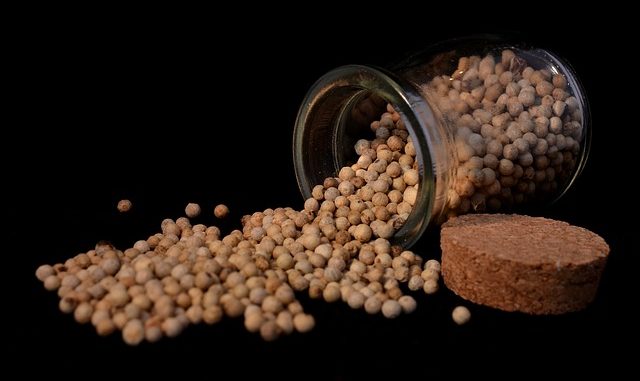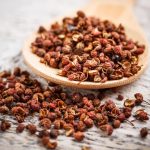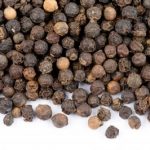
White pepper doesn’t always receive the press it deserves when it is often overlooked in culinary circles by black pepper. However it is always a remarkable spice to have and should be used with greater frequency. I was on an Italian cooking course not that long ago and it was the only spice were permitted to employ. Black pepper was a no-no.
Other Names
Blanc Poivre, Pimienta Blanca, Weisser Pfeffer, Hu Jiao Mian, Saphed Mirch & Beyaz Biber.
One of the reasons it is used is to actually give a dish a pungency without the flecking from black pepper. White sauces, fillings for pasta, potatoes especially mashed or even boiled and all their myriad dishes benefit hugely from the aesthetic and flavour perspective of the white variety. The Chinese regard it extremely highly for flavouring broth and especially clear soups like consomme, for pepping up a marinade or saute and for making a stir-fry fly with a zing. Black pepper can be a little bit harsh and doesn’t always give a dish the necessary warmth and depth that is needed. Have you ever tried it in gravy ? What about pastry ? What a stunning addition – it just makes you feel like another dimension was created just for this spice.
Where Does White Pepper Actually Come From ?
White pepper is produced from the same plant as black pepper and that is Piper nigrum. Pepper generally is a climbing vine found in south-west India. It is commercially grown across the world in Brazil, China, Sri Lanka, Vietnam and most of Africa. The vine grows to a height of 2-5 metres and uses surrounding trees and structures to support itself. The leaves are entire, alternate, 5-10cm in length and cordately ovate in shape, dark glossy-green in colour. The flowers are small, yellowy-white to greenish-white in colour and present in clusters of long drooping spikes 4-8cm in length in the leaf nodes. As the pepper berries develop, the spikes lengthen to between 7-15cm.
The way it is made means it is less harsh. The ground as well as whole pepper ingredients can be found in grocers. Ground pepper is probably best but needs to be stored carefully. I give it about 2 years before it is thrown on the compost heap !
White pepper is always produced from fully ripe pepper berries. Black pepper on the other hand comes from peppercorns of the same plant that picked just before ripeness. These are sun dried and the outer layer turns black. White pepper is soaked in water for about 10 days so that they ferment. The skins are removed. This also removes compounds like piperine which are the hot, pungent principles. A fair portion of volatile oil and other compounds that give black pepper its aroma are also scalped out. As a result, white pepper has a different heat, pungency and flavour to its more illustrious counterpart. The process used and handling of white pepper can introduce different flavor notes as well.
Remember, Szechuan pepper is a different species and not the same as these two peppers we talk about.
Nutrition Of White Pepper
White pepper is high in antioxidants and contains a suitable amount of fiber (fibre), and minerals like manganese and iron.
| Typical values | PER 100g | A serving contains the following |
|---|---|---|
| Energy | 1631kJ | 1631 kJ |
| 388kcal | 388 kcal | |
| Fat | 2.1g | 2.1 g |
| of which saturates | 0.6g | 0.6 g |
| Carbohydrate | 68.6g | 68.6 g |
| of which sugars | 0.0g | 0.0g |
| of which sugars | 0.0g | 0.0g |
| Fibre | 26.2g | 26.2 g |
| Protein | 10.4g | 10.4 g |
| Salt | 0.01g | 0.01 g |
For the chemically minded, two bisalkaloids called dipiperamides were isolated from white pepper. These inhibit cytochrome P450 which is involved in energy metabolism associated with the electron transfer chain. The remarkable feature of the molecules is that they contain a stabilised cyclobutane ring at the heart of the molecule (Tsukamoto et al., 2002).
Products
Purchase your white pepper products here
References
Tsukamoto, S., Tomise, K., Miyakawa, K., Cha, B. C., Abe, T., Hamada, T., … & Ohta, T. (2002). CYP3A4 inhibitory activity of new bisalkaloids, dipiperamides D and E, and cognates from white pepper. Bioorganic & Medicinal Chemistry,10(9), pp. 2981-2985 (Article).


Leave a Reply